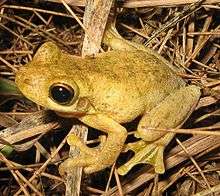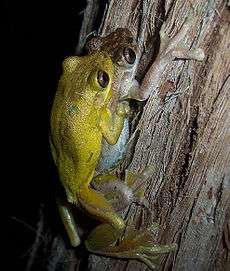Tyler's tree frog
Tyler's tree frog or the southern laughing tree frog (Litoria tyleri) is an arboreal tree frog. It is native to eastern Australia. It occurs from southeast Queensland to the south coast of New South Wales. It is generally a coastal species and is not found inland.[1][2][3]
| Tyler's tree frog | |
|---|---|
 | |
| Scientific classification | |
| Kingdom: | Animalia |
| Phylum: | Chordata |
| Class: | Amphibia |
| Order: | Anura |
| Family: | Pelodryadidae |
| Genus: | Litoria |
| Species: | L. tyleri |
| Binomial name | |
| Litoria tyleri Martin, Watson, Gartside, Littlejohn, and Loftus-Hills, 1979 | |
| Distribution of the Tyler's tree frog | |
| Synonyms | |
|
Pengilleyia tyleri | |
Etymology
The specific name tyleri honours Michael J. Tyler, an Australian herpetologist.[4]
Description

This frog is grey-brown to fawn (of various shades) on its dorsal surface, and a whitish-yellow on its ventral surface. Females are larger than males and reach a maximum size of about 50 mm. It has green flecks on the back. The iris is golden in colour and it has cross-shaped pupils. This species is very similar to the Peron's tree frog, (Litoria peronii). The easiest way to tell them apart is by call, butr L. peronii has strong black and yellow marbling in the thighs, armpits, hands and feet. L. tyleri has only faint yellow and brown marbling in the legs and armpits, lacking marbling in the hands and feet. This species lacks a strong black line above the tympanum, this line is present in L. peronii. As it is an arboreal frog, the toe pads are larger than its toes and fingers, allowing it to grip well on branches. Its hands are partially webbed, its toes are completely webbed, and the tympanum is visible. During breeding, males can turn a very strong yellow colour.
Ecology and behaviour
This species inhabits coastal forest and cleared land. It is normally found around permanent dams, swamps, and ponds. Males call from vegetation around the water body during spring and summer, often after rain. The call of this species resembles a short laughing noise, similar to that of the Peron's tree frog, but without a downward inflection.
As a pet
It is kept as a pet; in Australia, this animal may be kept in captivity with the appropriate permit.
References
- Jean-Marc Hero; John Clarke; Ed Meyer (2004). "Litoria tyleri". IUCN Red List of Threatened Species. 2004. Retrieved 3 February 2017.
- Frost, Darrel R. (2016). "Litoria tyleri Martin, Watson, Gartside, Littlejohn, and Loftus-Hills, 1979". Amphibian Species of the World: an Online Reference. Version 6.0. American Museum of Natural History. Retrieved 3 February 2017.
- "Litoria tyleri". AmphibiaWeb. University of California, Berkeley. 2008. Retrieved 3 February 2017.
- Beolens, Bo; Watkins, Michael; Grayson, Michael (2013). The Eponym Dictionary of Amphibians. Pelagic Publishing. pp. 341–342. ISBN 978-1-907807-42-8.
- Stephen Richards, Richard Zweifel. 2004. Litoria michaeltyleri. 2006 IUCN Red List of Threatened Species. Retrieved 11 June 2015.
- Frogs of Australia - Litoria tyleri
- Frogs Australia Network - Litoria tyleri-frog call available here.
- Article Road: List of All Frog Breeds: Things You Can Do to Ensure Your Frog Has a Long, Happy and Healthy Life: Tyler's Tree Frog
- Department of Environment and Heritage: Frog Keeper's License
- Department of Environment, Climate Change and Water, New South Wales: Amphibian Keeper's Licence: Species Lists
- Anstis, Marion (2006). Tadpoles of South-eastern Australia. Sydney: New Holland Publishing Australia Pty Ltd. ISBN 978-1877069499.
- Robinson, Martyn (2002). A Field Guide to Frogs of Australia. Sydney: Reed Natural History Australia. ISBN 978-1876334192.
External links
| Wikispecies has information related to Litoria tyleri |
| Wikimedia Commons has media related to Litoria tyleri. |
